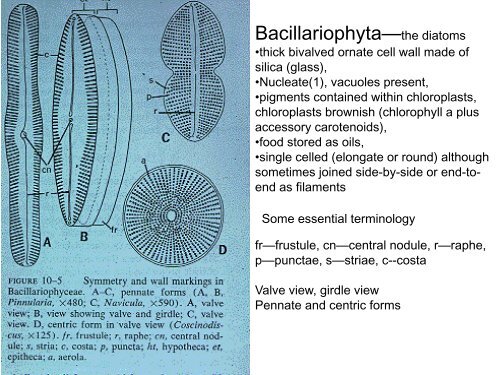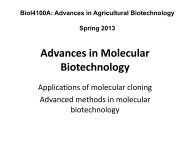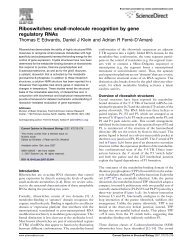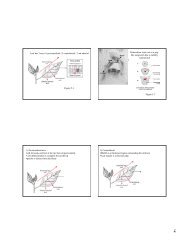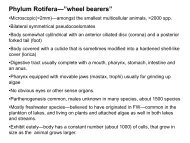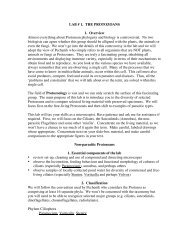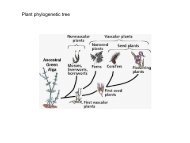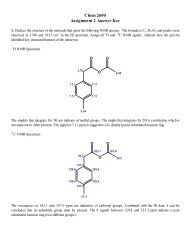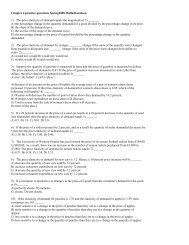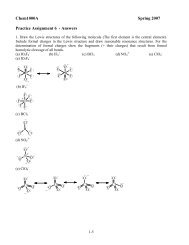You also want an ePaper? Increase the reach of your titles
YUMPU automatically turns print PDFs into web optimized ePapers that Google loves.
<strong>Bacillariophyta—the</strong> <strong>diatoms</strong><br />
•thick bivalved ornate cell wall made of<br />
silica (glass),<br />
•Nucleate(1), vacuoles present,<br />
•pigments contained within chloroplasts,<br />
chloroplasts brownish (chlorophyll a plus<br />
accessory carotenoids),<br />
•food stored as oils,<br />
•single celled (elongate or round) although<br />
sometimes joined side-by-side or end-toend<br />
as filaments<br />
Some essential terminology<br />
fr—frustule, cn—central nodule, r—raphe,<br />
p—punctae, s—striae, c--costa<br />
Valve view, girdle view<br />
Pennate and centric forms
Diatom in valve view, What does the word diatom mean?<br />
Central area<br />
raphe stria<br />
Central nodule<br />
Striae are composed of punctae (pores), what do you think their function is?<br />
Terminal<br />
nodule
The new valve is always a hypovalve—producing smaller and smaller cells<br />
Size range increases each generation<br />
http://images.google.ca/imgres?imgurl=http://www.jochemnet.de/fiu/bot4404/Dia_division2.jpg&imgrefurl=http://www.jochemnet.de<br />
/fiu/bot4404/BOT4404_19.html&h=424&w=400&sz=28&hl=en&start=5&tbnid=Ao72SPPZ1BjQBM:&tbnh=126&tbnw=119&prev=/imag<br />
es%3Fq%3Dreproduction%2B<strong>diatoms</strong>%26svnum%3D10%26hl%3Den%26lr%3D%26sa%3DG
Centric <strong>diatoms</strong> are oogamous, with flagellated<br />
sperm.Pennate <strong>diatoms</strong> are isogamous, with<br />
ameboid gametes<br />
The smallest cells become sexual and release isogamous gametes<br />
What type of sexual life cycle is this?<br />
http://www.mie.utoronto.ca/labs/lcdlab/biopic/fig/27.19.jpg
Some examples of pennate <strong>diatoms</strong><br />
generally raphed—capable of movement on substrate (1-20 µm s)<br />
solitary and benthic (in streams or wave washed shores of lakes) or epiphytic<br />
Gyrosigma<br />
Frustules raphed, valves sigmoid, raphe sigmoid with external proximal raphe ends recurved in opposite directions<br />
form one another. central area round to elliptical.<br />
A genus of benthic species, often in lakes and reservoirs.<br />
Around 100 microns long
Synedra: long straight needle-like cells, araphid, cells appear rectangular in girdle view, punctae (pores)<br />
arrange in rows (striae) axial area, fairly broad, common benthic species.<br />
About 100 microns long
Some pennate forms are colonial and live in the plankton<br />
Fragilaria:cells joined at the valve face to form ribbon-like colonies,<br />
Fragilaria colony cells joined side-by-side in<br />
girdle view, generally planktonic<br />
Valve view (on the left)<br />
Each cell 50-70 microns
Asterionella: elongate cells which are<br />
joined at the base to form stellate<br />
colonies, (seen in valve view) basal pole<br />
of the cell typically wider than the apical<br />
pole<br />
Fairly large for planktonic <strong>diatoms</strong>, each<br />
cell 50-70 microns<br />
Commonly found in dense blooms during<br />
May, prior to the onset of thermal<br />
stratification
Examples of centric <strong>diatoms</strong><br />
Non-raphed and non-motile<br />
Cyclotella: and Stephanodiscus<br />
•Solitary forms (non-colonial)<br />
•Usually abundant in spring & fall plankton<br />
20 µm
10 µm<br />
Melosira<br />
•a colonial (filamentous)form<br />
•valve surfaces joined end to<br />
end<br />
In the phytoplankton of lakes in the spring, but sink rapidly into the hypolimnion during the summer<br />
months, Some species grow attached to rocks in streams
Achnanthes: heterovalvular, one valve with and one without a raphe, flexed in girdle view, either solitary or in<br />
chains joined at the valvular surface, attached to substrate either by mucilage pad or by a stalk at the valve<br />
apex, valves ellipitical with rounded or protracted apices, striation and central area variable.<br />
http://craticula.ncl.ac.uk/EADiatomKey/html/Achnanthes.html<br />
Sometimes the striation and central areas of the raphed and<br />
rapheless valve can be different
Achnanthes longipes: alternation between a motile, solitary phase and a stalked sessile phase<br />
Under what conditions would this life cycle be advantageous?<br />
When inoculated into fresh media, the cells are at first motile (I), then become sessile and produce a stalk<br />
that anchors them to the substratum (II). This stalk continues to be synthesized as the cell is pushed away<br />
from the substratum (III), and eventually mitosis occurs producing a row of cells stacked one upon the<br />
other (IV). These cells eventually detach from one another (I) and begin the cycle again.<br />
http://www.bio.mtu.edu/the_wall/integrated_microscopy/a_longipes_general.html
Epiphytic pennate <strong>diatoms</strong>
Ecology of <strong>diatoms</strong><br />
•Extremely important primary producers in lake and ocean phytoplankton, and<br />
in the benthic algal communities of lakes and streams (20-25% of global PP).<br />
•Resistant to attack (predators pathogens) silica resistant to most enzymes.<br />
•Pennate (raphed) <strong>diatoms</strong> well adapted to life on hard substrates<br />
•Many pennate <strong>diatoms</strong> alternate between solitary and filamentous life styles,<br />
which suits them well for life in unstable environments.<br />
•Colonial centric forms adapted for life in the plankton of cold lakes and<br />
oceans—siliceous frustules sink rapidly, unless they have special shape<br />
adaptations.<br />
•Diatoms often form dense blooms in silica rich cold waters, mainly spring and<br />
fall, when the water column is well-mixed.<br />
•Diatoms are very tolerant of low light conditions<br />
•Most diatom species have narrow limits of tolerance and preference for<br />
chemical conditions in the water example, pH, alkalinity, salinity, Ca, P, N,<br />
organic matter, pollutants of various kinds, as well as temperature.<br />
•This, together with the fact that <strong>diatoms</strong> are so abundant and preserve well in<br />
sediment cores, makes <strong>diatoms</strong> very useful as indicators in paleolimnology.
Chrysophyta--Golden brown algae<br />
Cells small to medium (>10 microns)<br />
Nucleus (1),<br />
chloroplasts (2)brown to golden brown<br />
(chlorophyll a plus carotenoids),<br />
food stored mainly as oils and<br />
carbohydrates<br />
Unicellular or colonial, some species<br />
with flagellae (usually 2)<br />
Cell wall—often absent, sometimes<br />
present as a lorica (cellulose)<br />
simple unicellular naked flagellate
flagellate colonial form, a gelatinous matrix may be present but lorica absent--Uroglena<br />
Uroglena
50 microns<br />
large branched colonies, flagellate<br />
cells within a lorica—Dinobryon<br />
Important mixotrophic species in the<br />
plankton of lakes—consume bacteria
Ecology of Chrysophytes<br />
Common in the plankton of lakes especially during the colder parts of the year<br />
May occasionally form blooms that colour the water brown and give taste and<br />
odour problems—Eg Ochromonas<br />
Some species also found in cold steams and springs.<br />
Acid lakes and bogs, support a diverse Chrysophyte community, most important<br />
primary producers in such systems.
Pyrrophyta--Dinoflagellates<br />
•Cells fairly large (>25 microns)<br />
•Nucleate (1),<br />
•Cellulose wall often present<br />
•Cells with grooves (sulci) within which<br />
flagellae lie<br />
•Chloroplasts, 2 or more small disc<br />
shaped, brown to golden brown<br />
(chlorophyll a, c, plus carotenoids),<br />
•Food stored as starch and oils<br />
•Cells often emitting bioluminescence<br />
•Cells very motile (~ 5-10 mm/sec)<br />
•Often live as “mixotrophs” --ingest<br />
bacteria--phagocytosis
Ceratium<br />
cells armoured, with a sculptured cellulose<br />
wall often consisting of several plates,<br />
perforated with pores, and with deep<br />
transverse and longitudinal grooves<br />
large (>100 microns) with lobe like<br />
extensions “horns”<br />
> 100 microns long<br />
In the plankton of lakes and ponds
Gonyaulax—causes red tides, shellfish poisoning in estuaries<br />
Cells about 25-30 microns
Ecology of dinoflagellates<br />
Can be very important primary producers in both lakes and oceans<br />
Many dinoflagellates occur as symbionts inside animals eg corals or sponges<br />
Can cause toxic blooms, eg red tides, usually in estuaries—shellfish poisoning<br />
Very motile can usually maintain their position in the water column if they remain<br />
near the thermocline where turbulence is not too great<br />
Can produce bioluminescence in response to disturbance of the water column or<br />
predators.<br />
Many species are heterotrophic and mainly live by ingesting bacteria (phagocytosis),<br />
many such species have little chlorophyll.
Pfiesteria—a toxic dinoflagellate that<br />
forms lesions on fish skin<br />
Found in coastal rivers and estuaries<br />
mainly along the US east coast<br />
Pfiesteria piscicida<br />
Complex life-cycle with free living and<br />
parasitic ameboid phases—can produce<br />
toxins that are harmful to fish and possibly<br />
humans.<br />
Estuarine Associated Syndrome<br />
Symptoms include: headache, dizziness, skin rashes,<br />
nausea, muscle cramps, and short-term memory loss.<br />
However, not all Pfiesteria organisms are toxic


